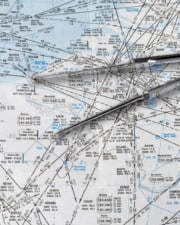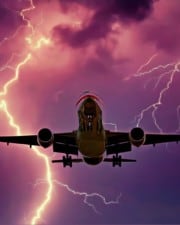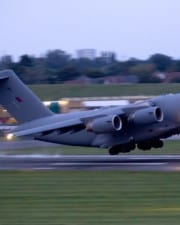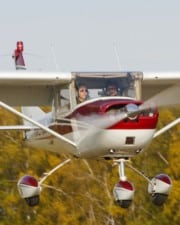Landing an airplane is a complex task that is made up of many smaller flight maneuvers. Pilots have terms for each phase of the landing approach, from the legs of the airport traffic pattern to the last runway rollout.
Table of Contents
What is the Landing Flare?
The landing flare, which is sometimes called the roundout, is when the pilot transitions from the final descent into the landing attitude. The flare is one of the hardest parts of learning to land a plane–it involves careful timing and understanding many factors affecting the plane.
Landing an airplane is a complicated maneuver that requires controlling the airplane through various configurations and speed changes. The goal of the “perfect landing” is to touch down softly, in a nose-up attitude, and just slightly above stall speed. While that all sounds easy on paper, in the cockpit of a moving airplane, it can be anything but.
Phases of landing
The phases of a normal landing are the final approach, the roundout or flare, the touchdown, and the landing rollout. While they are separate maneuvers, they are interconnected in that one must be performed well for the following task to succeed.
Stabilized approach concept
One key to making it all happen is the stabilized approach concept. A stabilized approach is when the aircraft is approaching the runway in the proper configuration, with the proper flap settings, and at the right airspeed. The plane should be trimmed for that speed, so it only requires small corrections from the pilot.
The final approach is flown in a stabilized manner until the aim point. The aim point is a specific spot that the pilot is flying towards. Most pilots use the painted number on the runway, although sometimes pilots use the runway threshold or runway touchdown zone markings.
Once over their aim point, the pilot begins reducing the power to idle and bringing the aircraft’s nose up to the landing attitude. To gauge how the airplane will settle on the ground, pilots learn to visually reference the aircraft’s nose in relation to the runway ahead.
The landing flare / roundout
If the final approach segment was made at the proper airspeed, the roundout should occur predictably. However, if the final approach was flown too fast, the plane will want to balloon back up into the air when the pilot attempts to roundout. If the pilot approaches the runway too slowly, the plane will quickly settle as they attempt their flare.
It’s up to the pilot to time it just right, to gauge their height as they bring the nose up. Ideally, the airspeed will bleed off little by little as the aircraft’s nose gets higher and higher. Since the plane is flying near stall speed, the plane should continue to sink towards the runway.
A proper landing flare is all about managing the amount of momentum or energy that the airplane has. The idea is to bleed off that energy gradually so that it will roll to a stop on the minimum amount of runway. If the plane has excessive momentum going into the flare, the pilot risks floating down the runway, overshooting their landing zone, or even running out of runway.

How Do You Know When to Flare on Landing?
Mastering the landing flare is not easy. For student pilots, it’s usually the most challenging part of learning to fly.
The landing flare represents the culmination of many other aspects of flying. To understand how to roundout the plane for landing, pilots must be well-versed at handling their planes at very low airspeeds. This is done throughout flight training, and during every landing, but not generally any other time.
Pilots also need to know how the local wind is going to affect their plane. The problems of crosswinds pushing the plane out of alignment with the runway aside, headwinds cause a reduction in speed over ground that makes the aircraft sink faster than usual.
All of this totals up to mean that pilots can seldom rely on formulaic answers alone. Aircraft landing procedures require that the pilot be focused and present. They’ve got to analyze the conditions every second of the procedure and make instant corrections as conditions change.
Roundout and all of the other phases of landing are discussed in the FAA’s Airplane Flying Handbook, Chapter 8.
Runway Optical Illusions
Another thing that can significantly affect landing flares is the presence of optical illusions. For example, a runway that is sloped uphill will make the pilot feel too high. A down-sloping runway has the opposite effect. It makes the pilot feel like they’re too low.
New pilots can struggle when they visit other airports. Runways are constructed in various widths. Many training airports have small runways, so the first time students visit an airport with a wider runway, they may feel like they are flying lower than usual.
If an optical illusion affects how high the pilot feels that they are, it will undoubtedly affect their flare to landing.
How Pilots Can Improve Their Landings
When learning to fly or just learning a new airplane, pilots practice landings ad nauseam. And it doesn’t change throughout their careers; they keep practicing and working to improve them.
No one is born good at landing airplanes, and every pilot has a bad one occasionally. It’s often jokingly said that any landing you walk away from is a good one. But pilots don’t really believe that–it’s just something you say to your buddy when they’ve made a really bad one.
Truthfully, pilots are judged all the time on their landings. Even the flying public knows it’s not easy–if it were easy, they’d be doing it themselves! Airliners full of passengers burst into spontaneous applause when their pilot greases it in.

So how can pilots make the magic happen every time? The answer isn’t going to satisfy many new pilot trainees, but practicing is the only way it happens. Pilots must practice landings frequently, in varying conditions and different aircraft.
The two rules for landings
There are really only two rules for landings. The first is that the stabilized approach concept should be mastered and respected. If a stabilized approach is not achieved, or if dramatic action must be taken to return the plane to a stabilized approach, the pilot must do a go-around. A go-around is an aborted landing. It means initiating a full-power climb out and rejoining the traffic pattern for another landing attempt.
The second rule of good landings is that a pilot must always be ready to do a go-around. That might sound counter-intuitive, but it reinforces the idea that a good landing only happens when many other factors are done right. If one of those factors isn’t going well, the best thing to do is start over again.
Luckily for airline passengers, by the time a pilot gets to that point in their career, they don’t need to do many go-arounds. But when trainees first begin, they do more go-arounds than actual landings. As they get better and better at it, they get to the point where they do very few go-arounds.
Related Posts













